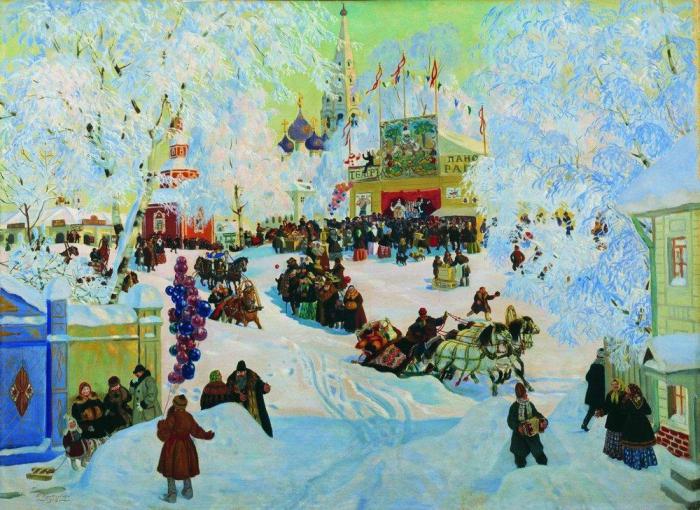Even those who are not too close acquainted with the history of Russian painting, at least once heard about Boris Kustodiev. The great artist is known not only in his homeland, but throughout the world, his paintings are sold at auctions and presented in the best museums on the planet. What was his life like and what works deserve attention in the first place?
Master biography
Boris Kustodiev was born on March 7, 1878 in Astrakhan, in the family of a seminary teacher. A year after the appearance of the son, the father passed away and the mother, Ekaterina Prokhorovna, raised her children alone. From childhood, the boy was fond of drawing, and in 1887 he visited the exhibition of Wanderers, where he was so impressed with what he saw that this determined his whole future life. Boris took lessons from the local painter Vlasov, and in 1896 he entered St. Petersburg at the Academy of Arts. There he ended up in Repin's studio and turned to the portrait genre. One of the very first works - Kustodiev's painting “Portrait of Y. Bilibin” - was recognized at an exhibition in Munich (in 1901) as one of the best works in this direction. So the genre became decisive in the work of the painter. The Academy was completed with a gold medal, then there was a journey through Europe and acquaintance with great artists, which Kustodiev himself would soon be among. The paintings, the description of which is most often associated with the philistine and merchant life, will become a real treasure for someone who is interested in Russian culture of those times. In 1909, Boris fell ill with spinal tuberculosis and spent the last fifteen years of his life in a wheelchair. Despite this, he remained cheerful and continued to work until 1927. In May 1927, the artist died in Leningrad.
Description of the painting "Shrovetide"

The most famous canvases of the artist are connected with subjects from Russian life and everyday life. The famous painting “Shrovetide” also applies to these. Kustodiev depicted on it the main square of a small town during festivities. The foreground depicts painted sleds on which people ride, on the sides are depicted walking rosy townspeople and children playing snowballs, there is a fair trade. The artist managed to perfectly convey the winter landscape, to create it, he used an amazing palette with blue, red and gold tones, complemented by turquoise and emerald. Depicted in the picture and the church, surrounded by trees. The colors used emphasize the good emotions and purity of thoughts associated with faith, which are saturated with a bright, festive painting "Shrovetide". Kustodiev created an opportunity for everyone who looks at the canvas to feel like part of the festivities. This is an incredibly optimistic work that allows you to get acquainted closely with the lifestyle of people of the late nineteenth century.
Description of the artwork "Lilac"
The painter created the spring and light canvas in 1906. Kustodiev’s painting “Lilac” is filled with joy and inspiration, on which the artist depicted his beloved family. The young wife and little daughter are painted on the background of lush lilac bushes that grew in the front garden near the house. Julia Kustodieva is dressed in the fashion of those times - in a magnificent white dress, which emphasizes a slender silhouette. She holds her daughter in her arms in a white dress with blue stripes. Kustodiev’s painting not only perfectly conveys his affection for the family, but also embodies the very weather of this day - lilac blooming in the sunshine is depicted with amazing accuracy and harmony.
Description of the artwork “Tradeswoman at tea”
The canvas depicting a Russian woman with a stout figure and a kind smile can be called the key in the life of the master. This picture of Kustodiev is familiar even to those who have not heard about his work. Tea drinking is depicted on the canvas, a large samovar is on the table and dishes with fruits, pies, jam, white bread are on display. Moscow scenes are visible behind: shopping arcades, monasteries, a white-stone church. In the picture, one can also note a slight irony - a magnificent and good-natured merchant with his feast evokes a smile in the viewer. In addition, there is a deep symbolism in the work - it was written in 1918, at a turning point, when many thought that Russia would never be the same, and its national features disappeared. The merchant woman in such a context becomes an image of a traditional way of life that will never disappear.
Description of the artwork “Merchant Counting Money”
Like others, this picture of Kustodiev is dedicated to Russian people and scenes from life. The canvas depicts a merchant whose expressive face is impressive. He has a firm and confident look, he knows how to work and is very tight-fisted, if not greedy. The gesture of his hand holding the money underlines the impression. But there is no negativity in the portrait. It was the merchant estate that developed the Russian economy of those times. The country was in first place in the world in 1913, and without people like the old man depicted in the portrait, this would have been impossible. Kustodiev succeeds very well with the genre scene with features of the portrait genre - like “The Merchant's Cup of Tea”, this work clearly reflects the artist’s work.